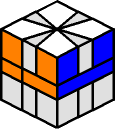

During this section, you must learn 3 different sequences.
By now, we know that the 2 trapezoids belong in the equator. But what about the wedges? If you haven't guessed by now, the answer is:
The stategy is to move up all the top corners to the top layer first; followed by placing them in their correct spots later.
Q: What color is the TOP SIDE?
A: WHITE; which means that the bottom side must be green. Square 1 seems to be committed to a single color scheme, so there's no sense going on (and on and on) about how to figure out what the colors are all by yourself. While we're at it, the front side is orange; and the left side is yellow (the same side that has the Square 1 logo). All the Square 1 web sites that I've seen unamonously agree that this is the universal color code.
You always have the option to move up a white corner to the top layer one at a time; but if you have 3 or 4 white corners on the bottom layer, then consider using this shortcut. Afterwards/Otherwise, go to the next sequence.
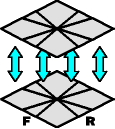 |
Desc. notaion: | |
b- R t6 b6 R b+ | JS notation: | (0,-1)/(6,6)/(0,1) |
What the move really does: it swaps the entire top layer with the bottom layer; corners, edges and all. Right now we are concentrating on the corners, so we don't care about the fate of the edge pieces for now.
When there are only 1 or 2 white corners on the bottom layer, then you have to use this sequence to move them up one at a time. Of course, if all 4 white corners are already on the top layer then you can skip this sequence altogether.
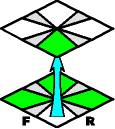 |
Desc. notaion: | |
t+ R b-3 R b-3 R b6 R t- | JS notation: | (1,0)/(0,-3)/(0,-3)/(0,6)/(-1,0) |
Don't worry about getting the top corner in the correct spot for now, just climb it up! We'll worry about fixing them later.
All 4 top corners are now on the top layer. The tops of all 4 corners are white, but what about their sides? At this point, there are 3 possibilities:
Now that we know the status of the top corners, it is time to fix them. Of course, if all 4 sides have matching colors, then the top corners are already solved.
Case I: No Side has Matching Colors |
||
| SET UP: | Do the Move: | Result: |
None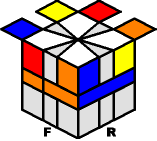 |
Desc. notation:t+ R b-3 R |
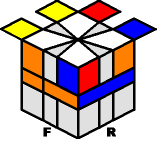 One side will have matching colors, so go to the next case. |
Case II: Only 1 Side has Matching Colors |
||
| SET UP: | Do the Move: | Result: |
| Rotate the top layer until the matching corners are both on the left side. 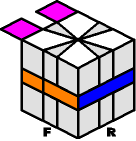 |
Desc. notation:t+ R b-3 R |
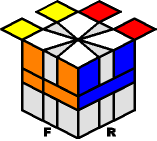 All 4 sides will have matching colors, so go to the next case. |
Case III: All 4 sides have Matching Colors |
|
 |
The top corners are already solved! Now you can proceed to solve the Bottom Corners |
In case you haven't noticed, the same move (for fixing the top corners) was used in both Case I and Case II; so just in case you are curious, here's what really happens:
| Desc. notation: | 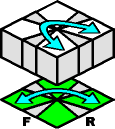 |
It swaps the adjacent right-side corners on the top layer, while swapping two opposite corners on the bottom layer | ||
t+ R b-3 R |
||||
| JS notation: | ||||
(1,0)/(0,-3)/ |
As you proceed to fix the top corners, the bottom corners become more and more scrambled; but you do not care about the fate of the bottom corners, since you are going to solve them next anyway.
NEXT: Solve the Bottom Corners